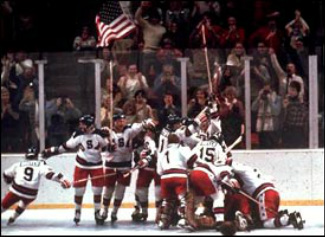 Film about 1980 US Olympic win illustrates social identity theories. Film about 1980 US Olympic win illustrates social identity theories. Tags: psychology/social psychology, sports, theory, henri tajfel, intragroup processes, intergroup processes, john turner, role identities, self-categorization theory, social identities, social identity theory, 06 to 10 mins Year: 2004 Length: 10:25 Access: YouTube Summary: This montage of two clips from the 2004 movie Miracle documents the United States Hockey Team’s win over Russia to secure the gold medal at the 1980 Winter Olympics; the montage also features footage from the actual game. In the first clip, U.S. head coach Herb Brooks asks the players to introduce themselves, which they do using their names, cities of origin, and university affiliations. In the second clip, the team has just lost a scrimmage game and Brooks keeps them on the ice to run drills despite the players’ exhaustion and coaching staff’s disapproval, until one of the players “reintroduces” himself; Brooks asks again who the player, Mike Eruzione, plays for, and Eruzione replies, “I play for the United States of America.” Upon hearing this, Brooks appears satisfied and ends the drills. This video can be used to illustrate several dimensions of Henri Tajfel’s social identity theory and/or John Turner’s self-categorization theory. I show this clip after students have read an overview of role and social identity theories by Thoits and Virshup (1997). First, it can be used to distinguish generally between role identities (who I am) and group or social identities (who we are). Sports teams, in general, are basic examples of I’s coming together to form we’s. Second, more specific principles within theories of social identity are illustrated. Tajfel’s psychologically oriented social identity theory focuses on intergroup processes of in-group and out-group formation, group conflict, and prejudice. Turner’s self-categorization theory is more focused on intragroup processes of categorization and depersonalization; in other words, the process by which individuals form a group. The Miracle montage is an illustration of both intergroup and intragroup processes, with the U.S.-Russia rivalry illustrating group conflict (intergroup) and the post-loss drills leading Eruzione to declare that he plays for the United States (depersonalization and categorization). This montage is especially useful at illustrating the processes of depersonalization and categorization as we watch the players go from identifying themselves as individuals to identifying themselves as members of the U.S. team. The somewhat artificial context of sports can be an accessible entry point to talking about other more “real world” contexts of group identity, both in terms of intergroup conflict and intragroup processes of depersonalization (e.g., ethnic, tribal, and state identifications and conflicts). Submitted By: Kathleen E. Denny
3 Comments
Manuel Franco
7/29/2023 02:04:30 am
I just want to say Thank You to everyone who supported me through the years. My name is Manuel Franco, New Berlin, Wisconsin. My story of how I won the Powerball lottery of $768.4M is a bit of a tale. I have been playing Powerball tickets for 6 years now since I turned 18. I bought my first ticket on my 18 birthday. I was feeling very lucky that day because I had contacted Dr. Odunga Michael to help me with the winning Powerball numbers. I really had that great great feeling that I looked at the camera wanting to wink at it. I only did a tiny part of it and trusted him. He gave me the numbers after I played a couple other tickets along with it for $10. I checked my ticket after the winnings came online and saw the numbers were correct including the Power play. I screamed for about 10 minutes because it felt like a dream. I had won $768.4M. You can check my winning testimony with the lottery officials just with my name search. Thank you Dr Odunga. Well, his email is [email protected] and you can also call or Whats-app him at +2348167159012 so you guys can contact him
Reply
mark hold
7/7/2024 03:05:52 pm
One faithful day as i was watching a video on you tube i saw a comment of one MR PAUL HAVERSACK testifying of this great herbal healer doctor Moses Buba,That helped him enlarge his manhood .i was shocked and happy, so i quickly visited his website and emailed him within 30 mins he got back to me and told me all i need to buy and i did so after 4 days i received his herbal medicine ,he gave me instructions on how to use it ,as i am speaking to you people now after using the cream for just two weeks my manhood size is 10 inches long and 8.0 girth ,,am so happy and grateful for his work in my life thank you so much Doctor Moses buba ,,i also learnt he has cure for LOW SPERM COUNT,PREMATURE EJACULATION,ERECTILE DYSFUNCTION,HIV/AIDS VIRUS,DIABETES 1/2,HERPES DISEASE,CANCER,and lots more
Reply
Leave a Reply. |
Tags
All
.
Got any videos?
Are you finding useful videos for your classes? Do you have good videos you use in your own classes? Please consider submitting your videos here and helping us build our database!
|
 RSS Feed
RSS Feed
